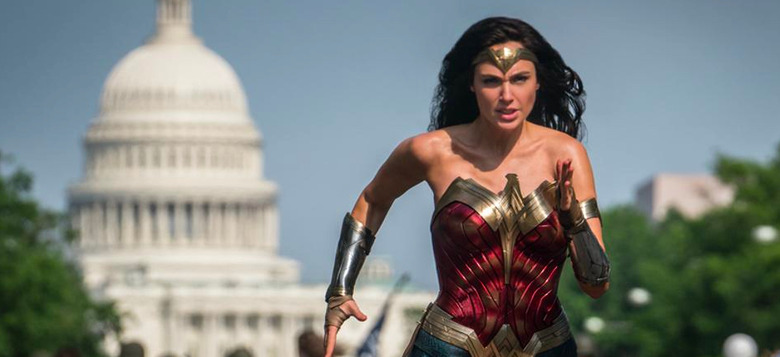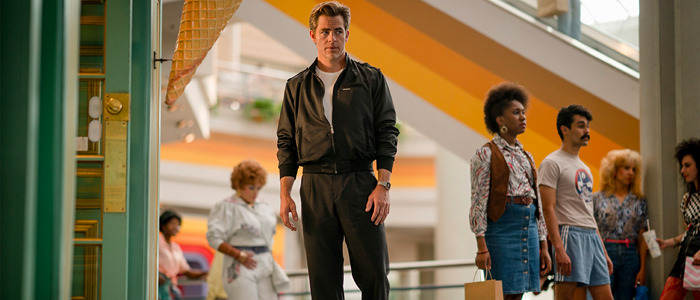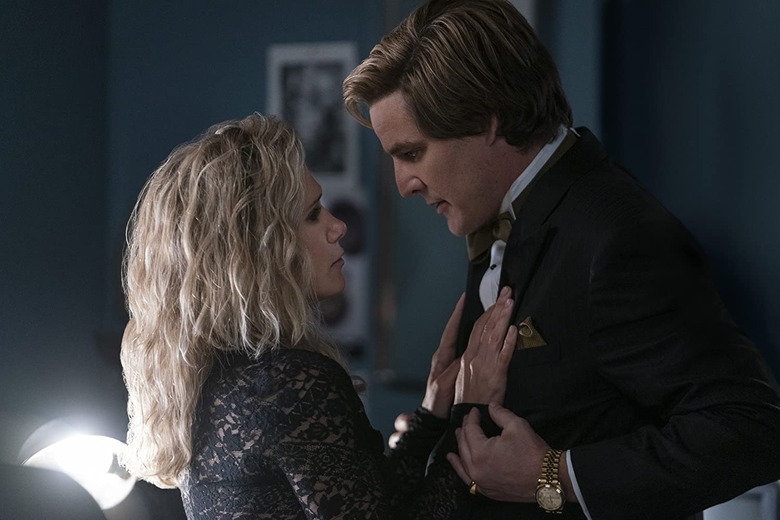'Wonder Woman 1984' May Be Set In The Past, But It's A Superhero Movie About Today [Set Visit Report]
A pristine recreation of a White House corridor sits in the center of a dark soundstage, where reversing heavy machinery are blaring sirens, Amazon warriors are passing through to get coffee, and confusion reigns. Calmly navigating this controlled chaos is director Patty Jenkins, who smoothly handles several crises while sitting down with a group of journalists visiting the London set of Wonder Woman 1984 in late 2018. She looks positively unruffled, balancing a coffee cup on her knee as a production assistant frantically whispers in her ear about the latest emergency.
"She's like a real-life Wonder Woman," I muse to a fellow journalist. It sounds cheesy, I know, but Jenkins would have approved of the corniness. Her 2017 blockbuster phenomenon Wonder Woman wore its cheese on its sleeve, with Gal Gadot's heroine not hiding her earnest nature and optimism for humanity. It's a sentiment that Jenkins seeks to continue with the upcoming Wonder Woman 1984, which follows Gadot's Diana Prince in a new adventure in the '80s.
"It's funny; on the first movie, you're so going on faith [of], 'I believe this feels right for Wonder Woman and for the world,'" Jenkins tells us of the raised expectations for Wonder Woman 1984 after the sensational critical and box office success of the first film. "And of course it's certainly not right for everybody, but to have the world speak back and embrace what the movie was and embrace that we were on the right track is pretty incredible. And so now it just kind of encourages us to have even more fun and really enjoy the stuff that we love. You end up doubling down on what you really love. I mean, actually, it doesn't change that much. You're trying to make the best story you can last time, and I'm trying to make the best story we can this time."
What is the story this time? Wonder Woman 1984 picks up with the princess of Themyscira "in the age of glamour and excess," after she has been living among humanity for nearly 70 years. Working at the cultural anthropology and archeology wing at the Museum of Natural History in Washington, D.C., Diana spends her time remembering her lost love Steve Trevor (Chris Pine) and dutifully continuing to protect humanity.
"She's very slightly disengaged with the world, and a bit lonely, as the world whips around her, as people chase after dreams of wealth and power and fame," associate producer Anna Obropta adds. "Dreams that are apparently for sale by the president of Black Gold International, played by Pedro Pascal. This is this desperate, self-obsessed, fraudulent entrepreneur who runs a business selling the American Dream."
A fraudulent businessman who makes his name selling the illusion of the American Dream? That sounds a little too familiar. With the film's setting in Washington, D.C. (and a theatrical release set a month before the 2020 election) Wonder Woman 1984 seems to be making a pointed critique at our current administration. But why is it set in the 1980s and not modern day? "America was at the peak of its power and pride," Obropta tells us of the very intentional choice to set the film in 1984 — a year that significantly was also the setting of George Orwell's dystopian classic. "It was everything from commercialism, fashion, wealth, even violence was in excess.... It was humanity at its best and at its worst."
And this culture of excess doesn't sit quite well with the Amazonian princess, who sports some of the trendiest styles herself, but doesn't approve of the "greed is good" philosophy that the decade (and one of its most popular movies) was becoming associated with.
"It was a very, very powerful decade," Gadot says. "There's also...a lot of greed and a lot of bad things that that are being done in order to get to the top. And I think that she doesn't like that so much: the price that people are willing to pay in order to achieve whatever it is they want to achieve."
The Dream of the '80s is Alive in Washington
Nostalgia for the '80s is all the rage in Hollywood, with shows like Stranger Things and movies like Ready Player One kicking off a craze for big hair and even bigger pop culture references. But it's more than aesthetic or trendy choice for Wonder Woman 1984. There are plenty of costume changes for Diana, of course, but the '80s and its legacy of rampant materialism and political corruption — much of which feels especially prescient today — was of particular interest to Jenkins:
"It was particularly the '80s because of the fact that that was the height of everything that we're now paying the price for. It was like we thought for sure it could go on forever and there was going to be no price and you could just [have] exponential growth then it could keep going, and all of this excess. And so I think in that way [what] we're talking about then, we're also talking about right now. We're talking about what we're dealing with right now because that struggle is very much alive in our own psyche."
Jenkins tiptoes around saying what exactly "we're dealing with right now" but the intention is obvious. Even when Wonder Woman 1984 began shooting in 2018, the headlines were dominated by President Donald Trump and the culture of extremism that had risen around him. Drawing the connection between Ronald Reagan, the definitive U.S. president of the '80s and an icon of conservative politics, to Trump is a fairly straight line. Both came from the entertainment industry, both had cultivated a cult of personality, both (at first) reaped the economic rewards of the policies laid by their predecessors. And both were elected as a clear refutation of the progressive movements that were beginning to make inroads in America — Reagan to the counterculture and feminist movements, Trump to race relations. Under Reagan, the '80s saw a newfound embrace of capitalist excess and American exceptionalism....sound familiar?
"We're trying to give a broad perspective of that period and how we can learn from that period in every way," producer Charles Roven says. "Because it has a lot of colors to it. I would say that you can, you know, you can imagine what was going on culturally and current events at the time has some relevance to the picture."
"1984 because it was a year of lessons learned, lessons for a goddess warrior and lessons for all of us," adds Obropta.
Hammering in those political parallels is the film's setting in Washington, D.C. Wonder Woman 1984 shot on location in D.C., and like Captain America: The Winter Soldier, Marvel's superhero film that takes place in the nation's capital, it gives particular significance to the setting.
"We had a blast shooting in Washington," Gadot reminisces. "It's beautiful and it's definitely going to have a lot of presence in our movie. The movie is not a political movie, but you can definitely — you know, it taps on issues that are very current."
But Wonder Woman 1984 isn't intended to be a full-blown political satire. It's still a superhero movie, albeit one that appears to be making a pointed critique at the current political landscape, what with its setting in 1984 Washington, D.C. Which means there will be as much celebration of the '80s, in all its high fashion and high energy, as there are critiques, Obropta says:
"Our version of the '80s, if you look over here, there's nothing kitsch or cliche about our take, or Patty's take, on the '80s right? There are many, many films set in the '80s, but this isn't like the funny 'ha ha' mockery. We do have fun with the rich cultural backdrop, for sure...but the intention is for it to be a celebration of the cutting edge design, fashion, the glamour, the lighting, the color, really celebrating the best of the decade."
As You Wish: Steve Trevor's Return
But the biggest hook of Wonder Woman 1984 isn't its '80s setting, nor its veiled political commentary. It's the return of Steve Trevor, Diana's first love, who tragically gave his life to save the world at the end of Wonder Woman. Diana hasn't been the same since Steve died; faithfully performing her duties in the world of men for 66 years, but keeping a distance to the people she protects. Gadot tells our group of reporters in a paired interview with Pine:
"She's been involved in the Men's World when she was needed. She doesn't really want to make close connections with anyone, because she knows, either she's going to hurt them because she'll have to disappear one day, or she will lose them because they'll grow old. So I think after the loss of Steve and the entire team later on, I think Diana is in a place where she's happy where she is. She's fairly lonely, but she made the decision to do that. And she does go to the world whenever it's needed. But she's not complete, you know what I mean? She has issues."
Then, like a miracle, Steve Trevor returns. What's the reason? How does he resurrect from the dead? Won't this undercut the impact of his death? Those are questions that won't be answered until we see the movie, but the concept of bringing Steve back and exploring the relationship beyond the "will-they-won't-they" that made the first film such a huge hit was something that Jenkins conceived about halfway through shooting the first Wonder Woman. And Pine was on board.
"Patty told me this idea — it must have been, like, halfway into the first film, so she kind of had an idea, and she was kicking it around," Pine says, adding:
"Patty is a cinephile and a lover of all storytelling, and there are definitely nods to — just like she did with Superman [with the first Wonder Woman]— there's nods to filmmakers of the past. She's a lover of classical Hollywood storytelling, and I think there's something huge and grand, and old romance about it."
The meet-cute between Steve and Diana in Wonder Woman, more typical of rom-coms than comic book movies, will give way to the grand romance of classic Hollywood, Pine teases. Gadot agrees, adding that Wonder Woman 1984 also expands the relationship beyond their first sparks and first goodbyes, and into unknown territory. Basically: what happens after the star-crossed lovers are no longer star-crossed?
"I think Steve and Diana have a really special dynamic that's really wasn't fully explored in the previous movie, because we just met and we just built a relationship," Gadot says. "And now we got an opportunity to kind of continue from where we stopped last, and now we're doing it after, at least my character, carried the big loss of him all those years, so having someone that you love so much after so many years, and be with him again is just like, great."
Gadot turns to Pine for confirmation, "Yeah, right?"
"Yeah," Pine supports, "the first one was about falling in love, when you have that wonderful 'will they, won't they,' and so much about their personalities don't fit, but they do, goddamnit, and we want them to, that kind of thing. The consummation has already happened, so now it's an exploration of that missing and that longing and knowing what it is, so there's the strength of that bond."
Maxing Out the Villains
While Steve Trevor finds himself a man out of time, the villains of Wonder Woman 1984 are very much of their time. Though "they're not the most obvious villains," Gadot says, adding that the depth that writers David Callaham, Geoff Johns, and Jenkins imbue Cheetah and Maxwell Lord with made them almost as likable as the film's leads:
"When I first read the script, I told Patty, 'Wow, I like I like them as much as I like Diana and Steve.' And this goes to our wonderful writers [David Callaham] and Geoff [Johns] and Patty — they really managed to create villains that every — I'm so tired of the obvious villain, the German soldier that you know from the get-go, okay he's the bad guy — they're like real people. Just like you, and you, and me . They're just in a position where — I don't know if I can say that. We can see ourselves in them. And they're not bad people per se. But they just didn't make the right choice at the right time. And I find it so interesting and so appealing, and I actually care about them."
For Jenkins, it was her intention to choose villains that were symbolic of the times, and symbolic of Diana's own emotional journey. And for Wonder Woman 1984, Maxwell Lord and Cheetah fit the bill perfectly. Cheetah has always been one of Wonder Woman's biggest rogues, with the character of Barbara Minerva — who in the comics is an archaeologist transformed into a bloodthirsty cheetah hybrid through a curse — often viewed as her main archenemy; all rage and envy compared to Wonder Woman's dignified compassion.
"There have been many physical manifestations of Cheetah, but the core has always been the same, which is someone who wishes they could be like these other superheroes and gods, " Jenkins says. "And that already is kind of emotion run amuck; that's already a little dangerous because what are they wishing for? Not necessarily to save the world. So I think that all stays very much in tune with the core."
But how does Pascal's Maxwell Lord fit into the mix? With Wonder Woman 1984 changing the origins of Cheetah to fit more thematically with its themes of '80s excess and the illusion of the American Dream, Maxwell Lord may have more to do with Cheetah's transformation than initially appears. For Jenkins, Cheetah may provide the emotional core, but Maxwell Lord provides the fun.
"He's a great character," Jenkins gushes. "He's just great and he's a super part of the times, and that's what was so fun about him to me. It's like, what is the epitome of the 80s, but also very symbolic to our times right now? Which is like somebody who's everything about that era and what we believed in then that has resulted in who we are now."
***
Wonder Woman 1984 is scheduled to hit U.S. theaters on October 2, 2020. But before that, expect to see brand new footage from the film at the DC Fandome virtual event on August 22, 2020.



